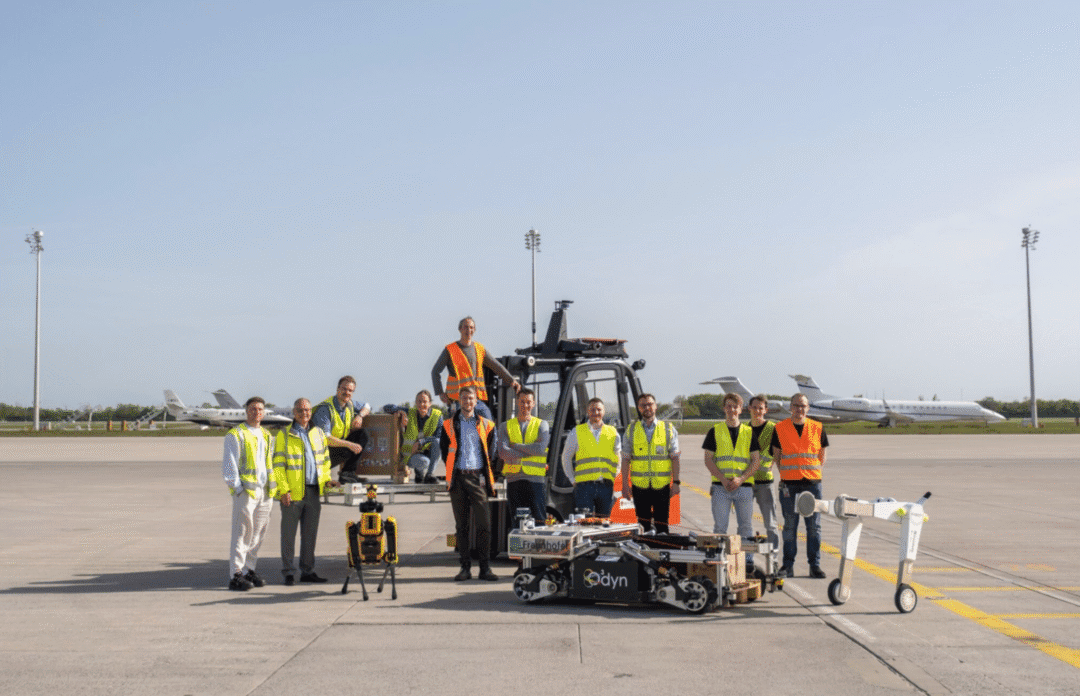The integration of autonomous robots into live airport cargo environments is no longer a hypothetical exercise. In Germany, what began as a research initiative has moved into active deployment, with five autonomous robots having undergone real-time testing at major airports, including Munich and Stuttgart.
Far from lab-based trials or controlled simulations, these robots are navigating the complexities of dynamic cargo hubs—sharing space with humans, vehicles, and the full unpredictability of airside logistics. The ambition, says Manuel Wehner, Project Lead at the Fraunhofer Institute for Material Flow and Logistics (IML) based in Frankfurt am Main, Germany, is to build something that can not only survive but optimise performance in the real world.
“We tested five robots so far along the actual process flow at the airport,” Wehner told Air Cargo Week. “They were not placed next to or behind a fence, but in live operations, transporting containers or loading ULDs at our partner airports Munich and Stuttgart.”
Dynamic environments demand autonomy
Unlike warehouse robots that follow static lines or pre-mapped zones, airport cargo robots must respond to a constantly shifting operational environment. This is not just about logistics; it’s about resilience, decision-making, and safety in high-traffic zones.
“The robot needs to be truly autonomous,” said Wehner. “It needs to find its way if someone parks in its path, or if a tractor unexpectedly passes by. There’s no use having a robot that just stops and waits.”
The project, led by the IML as part of the Digital Testbed Air Cargo (DTAC), funded by the German Federal Ministry for Digitalization and Government Modernization (BMDS) with €13.7 million, has tested robots across various use cases—transporting containers, loading and unloading ULDs, and integrating with terminal gates. These tests aim to identify how robotics can supplement rather than replace human labour, especially in regions with acute workforce shortages. Currently, a new robot for ULD handling is being developed from the scratch in IML’s laboratories, incorporating the findings from previous tests. Furthermore, the DTAC project team is developing AI-based algorithms for predictive cargo operations and hands-on applications for IATA’s ONE Record data standard.

Robots as infrastructure
Another key insight from IML’s field trials is that airport automation is not simply a matter of deploying high-tech machines. It’s about embedding robotics into the wider digital and physical infrastructure. This requires designing a modular control system that allows for multiple robots—often from different manufacturers—to operate in parallel.
“The smarter the control system software is, the less intelligent the single robot needs to be,” Wehner explained. “That’s the key. We can then make the robot cheaper, easier to maintain, and quicker to deploy.”
At the heart of this approach is openTCS, IML’s open-source robot fleet control software. Developed over more than a decade for other industries, it enables plug-and-play integration of different robotic vehicles, supporting scalability without vendor lock-in. openTCS is currently being updated and further developed for airport applications.
“You won’t have to redo the entire work if you change the manufacturer or the robot type,” said Wehner. “You can just adapt the control software and continue operations.”
Lessons from live testing
Real-world deployment has revealed crucial lessons that could never be captured in simulation environments. Issues like misaligned pallets, ambiguous lighting conditions, and inconsistent signage have forced the team to refine robot sensing, mapping, and decision-making in ways that will benefit future rollouts globally.
Wehner describes these small failures as essential to making robust systems.
“It’s a good thing when it fails. That’s how you learn what needs to be improved. If you test only in the lab, you won’t find those gaps.”
This iterative approach is designed to produce systems that can handle airport-specific chaos. The team is also developing training tools and digital twins to simulate full operations before physical deployment, helping airports reduce disruption during rollouts.
With successful pilot phases now underway, IML’s long-term goal is to support airports in building robotics ecosystems that are open, maintainable, and adaptable. The project avoids commercial lock-in by remaining manufacturer-neutral, providing open-source solutions, and focusing on enabling infrastructure rather than proprietary solutions.
“We are not a robotics company trying to sell hardware,” Wehner clarified. “Being a non-profit organization, we’re developing public knowledge and tools that others can build on. Airports can create their own fleets, suited to their needs, and evolve them over time.”
The concept isn’t just for major hubs either. Smaller and regional airports, facing the same labour shortages but lacking automation budgets, stand to benefit the most from modular, low-cost systems driven by smart software.
As more cargo handlers and airports begin evaluating robotics, Wehner believes the industry will need to collaborate on setting digital standards. From data interfaces to fleet APIs, future success will depend on cooperation between manufacturers, IT providers, handlers, and regulators.
“Everyone talks about digitalisation, but if you don’t know what data you actually need or how to interpret it, then it’s useless,” he said. “It’s about what you do with the data, not just having it.”
On behalf of the DTAC consortium, Wehner recently accepted TIACA’s ‘Sustainability Award’ in Hong Kong in June 2025 and an ‘International Award for Excellence in Air Cargo’ in Nairobi in February 2025 for the tests of a heterogeneous robot fleet at the DTAC partner airports MUC and STR in 2024. Furthermore, the DTAC consortium was a top-5 finalist at the ACW World Air Cargo Awards in Munich in June 2025.





